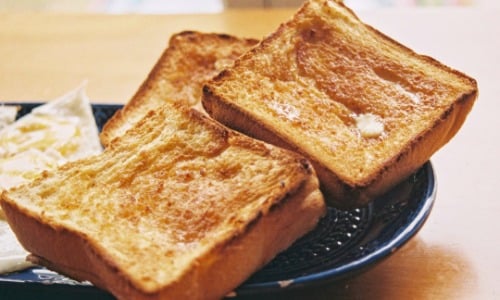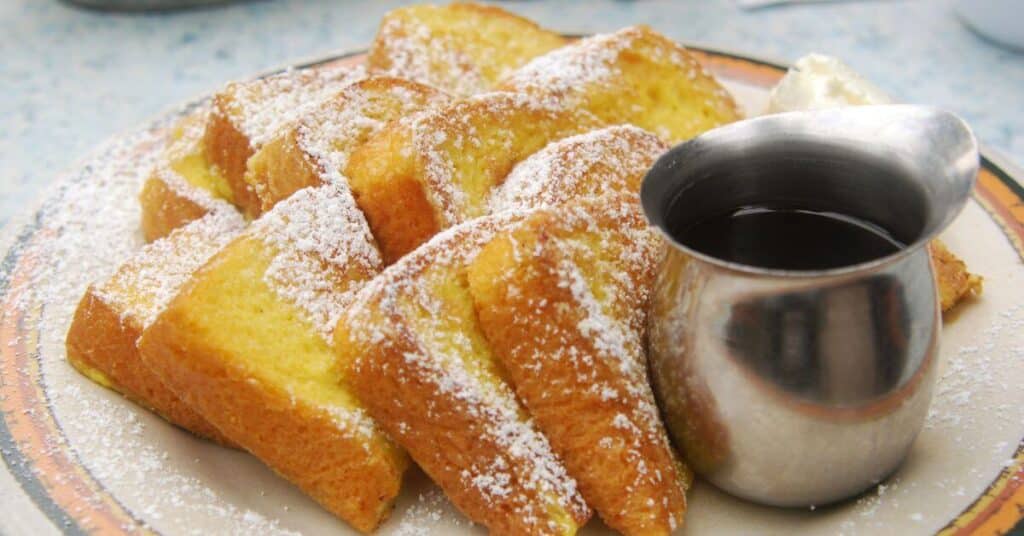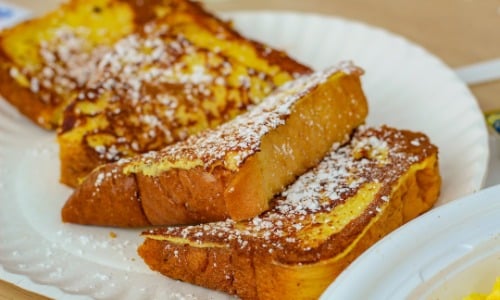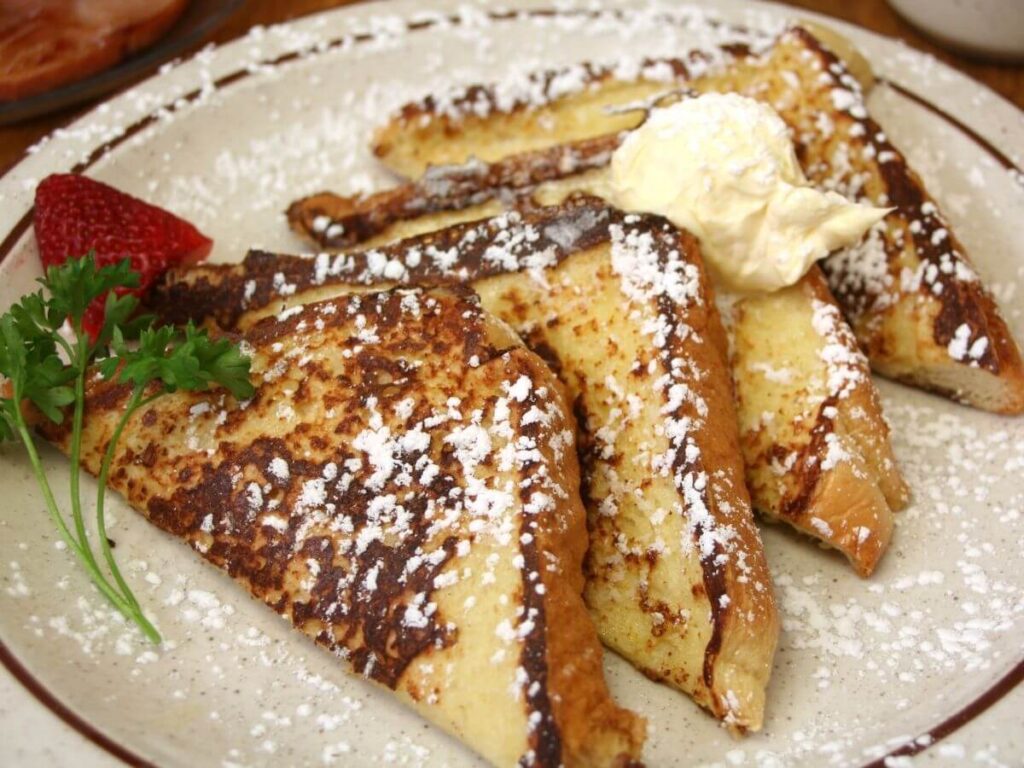French toast is a breakfast favorite for many, loved for its sweet taste and custardy interior. Typical recipes call for milk to create that beloved texture and richness. But whether you’re out of milk or need a dairy-free option, you can still enjoy this classic dish. You can use a variety of substitutes such as water, plant-based milks, or simply increase the number of eggs in your batter to achieve a similar flavor and consistency.
Making French toast without milk is easy and might become your new go-to recipe. By using alternatives like almond milk, coconut milk, or even orange juice, you can cater to dietary restrictions or just try something new. You’ll find that the process is very similar to traditional French toast, and the results can be equally delicious. So grab your favorite bread, and let’s get started on creating a milk-free French toast that might just surprise you with its delightful taste.
Ingredients for Dairy-Free French Toast
Creating dairy-free French toast is simple with the right ingredients. You’ll need to select suitable bread, choose a non-dairy milk alternative, and mix a few essential ingredients to achieve that classic French toast flavor.
Choosing the Right Bread
When selecting bread for your dairy-free French toast, consider brioche, challah, or French bread for a rich and indulgent taste. However, if you prefer, wheat bread can also provide a delicious and healthier option. Look for loaves that are a day or two old, as slightly stale bread absorbs the egg mixture better and provides a firmer texture.
Finding the Best Milk Substitute
For the liquid base of your egg mixture, you can choose among various non-dairy milks. Popular substitutes include:
- Almond milk: Mild in flavor and widely available.
- Soy milk: Nutrient-rich with a creamy consistency.
- Coconut milk: Offers a hint of sweetness and tropical flavor.
When choosing your substitute, opt for unsweetened and unflavored varieties to maintain control over the sweetness and flavor profile of your French toast.
Mixing Essential Ingredients
To create your dairy-free egg mixture, you will need:
- Eggs: Beat them well for a smooth, cohesive mixture.
- Dairy-free milk substitute: 1 cup of your chosen milk alternative.
- Cinnamon & Vanilla Extract: A teaspoon of each for a classic flavor.
- Vegan butter or dairy-free butter: For cooking your French toast to golden perfection.
Combine these ingredients thoroughly before soaking your bread slices. Each slice should be soaked but not soggy before transferring to a hot pan coated with melted dairy-free butter.
Cooking Techniques and Equipment
To make exquisite French toast without milk, you need the right tools and techniques. Your skillet or griddle choice, along with the cooking method, play pivotal roles in achieving that desirable golden brown finish.
Preparing the Skillet or Griddle
Before heating things up, choose your surface wisely. If you prefer a classic approach, a cast iron skillet gives your French toast a crisp edge. For convenience, a non-stick skillet ensures easy flipping and reduces the risk of sticking—a tablespoon of butter goes a long way here, adding rich flavor and contributing to a non-stick surface. Meanwhile, a griddle provides ample space for cooking multiple slices at once. Here’s what you need to do:
- Heat your skillet or griddle over medium heat.
- Melt just enough butter to coat the cooking surface, avoiding excessive oiliness.
Achieving the Perfect Golden Brown
Your technique is crucial to reaching that perfect color and texture. French toast is at its best when it’s golden brown, with a slightly crispy exterior and a soft, warm center. Your eggs and cinnamon work together to create this effect while also adding depth to the flavor. Follow these steps:
- Dip each slice of bread in the egg mixture, allowing excess to drip off.
- Place the bread into the skillet and watch closely.
- Cook for 2-4 minutes per side or until each side is golden brown. Adjust the heat as needed to avoid burning.
Remember, practice makes perfect. Don’t be afraid to adjust temperatures and timing to suit your cooking style and preferences.
Customizing Your French Toast
Creating French toast without milk opens up a plethora of options for customization, allowing for both sweet and savory twists, as well as vegan-friendly alternatives. Embrace the diversity of toppings and dairy-free ingredients to make your French toast uniquely yours.
Sweet and Savory Toppings
Pairing your French toast with sweet toppings can transform your dish into a delightful breakfast or dessert. For a touch of classic sweetness, drizzle maple syrup atop your warm slices. A dusting of powdered sugar adds a subtle sweet note with a hint of sophistication.
Alternatively, consider a fruit-forward approach by adding fresh fruits. Here’s a quick list:
- Berries: blueberries, raspberries, strawberries
- Bananas: sliced or mashed
- Apples: sautéed in cinnamon
For a savory twist, consider adding a sprinkle of sea salt or pairing with crisp bacon. You can also experiment with sweet and savory combinations, like topping your French toast with a dollop of whipped cream and a side of applewood smoked bacon.
Vegan and Dairy-Free Variations
To cater to vegan and dairy-free diets, substitute traditional ingredients with plant-based alternatives. Here’s a simple guide for swaps:
| Traditional Ingredient | Dairy-Free/Vegan Substitute |
|---|---|
| Butter | Coconut oil or margarine |
| Milk | Almond, soy, or oat milk |
| Eggs | Banana or flaxseed mixture |
Enhance the flavor of your dairy-free French toast by adding a teaspoon of vanilla extract to your egg substitute mixture. A swirl of jam can also add a burst of fruity sweetness without the dairy.
Whether sweet or savory, rich or light, personalize your French toast to enjoy a comforting meal that aligns with your preferences and dietary needs.
Storage and Reheating Tips
When you’ve made a delicious batch of French toast without milk, you might find yourself with a few leftovers. It’s important to store your French toast properly to maintain its taste and texture for future meals. Here’s how to keep your French toast fresh and how to reheat it when you’re ready to enjoy it again.
Storage:
- Countertop or Fridge? Preserve your French toast by storing it in the refrigerator within two hours of cooking. French toast shouldn’t be left on the countertop for extended periods due to the risk of bacterial growth.
- Airtight Container: Place your French toast in an airtight container; this will keep it from absorbing other flavors and maintain its freshness.
- Freezer-Friendly: To freeze French toast, wrap each piece individually in foil or plastic wrap, then place them in a freezer bag. It can last in the freezer for up to 2 months.
| Where | How Long | Container Type |
|---|---|---|
| Refrigerator | 1-2 days | Airtight |
| Freezer | Up to 2 months | Individually wrapped |
Reheating:
- Oven or Toaster: To reheat French toast, you can use an oven preheated to 350°F (175°C) for about 10 minutes, or pop it in the toaster until it’s warm and crispy.
- Skillet Method: For a quick warm-up, use a skillet over medium heat. Heat each side for 1-2 minutes until heated through.
- Microwave: While not ideal, you can use a microwave in 30-second intervals to avoid making it soggy.
Remember, reheating French toast doesn’t alter its calories or fat content significantly. It’s always best to enjoy it freshly cooked, but these tips will help you keep that delectable taste and texture for when you’re ready for more!
Frequently Asked Questions
French toast without milk is definitely possible and can still be delicious. Here are some alternatives and tips to help you along the way.
What are some good milk substitutes for making French toast?
You can use a variety of milk substitutes such as almond milk, soy milk, oat milk, or rice milk. Each of these will impart a slight flavor difference, so you can choose according to your preference.
Can yogurt be used in place of milk for French toast recipes?
Yes, yogurt thinned out with a bit of water works as a great substitute. It gives the French toast a tangy flavor and a rich texture.
Is it possible to make French toast with coconut milk for a dairy-free option?
Absolutely, coconut milk is a creamy and flavorful dairy-free substitute that works well in French toast. Just be aware it will add a coconut flavor to your dish.
How can I make French toast if I don’t have any milk or vanilla on hand?
You can simply use water with a pinch of sugar or a sweetener of your choice to dip your bread. It won’t be as rich, but it will still allow you to enjoy a version of French toast.
What role does milk play in the texture and taste of French toast?
Milk contributes to the custard base, providing moisture and richness that yields a soft and slightly sweet interior. When using substitutes, try to mimic this balance of moisture and flavor.
Can I achieve a less soggy French toast without using milk?
Yes, using milk substitutes with less water content, like coconut cream or thicker non-dairy milks, can help you achieve a less soggy French toast. Control the soaking time to manage sogginess regardless of the substitute used.




